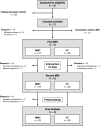Mindfulness meditation increases default mode, salience, and central executive network connectivity
- PMID: 35918449
- PMCID: PMC9346127
- DOI: 10.1038/s41598-022-17325-6
Mindfulness meditation increases default mode, salience, and central executive network connectivity
Abstract
Recent research has begun to identify the neural mechanisms underlying the beneficial impact of mindfulness meditation training (MMT) on health and cognition. However, little is known about the effects of MMT on the global interplay of large-scale networks (LSNs) in the brain. In the present study, healthy, meditation-naïve adults (N = 46) underwent resting state fMRI prior to and upon completing 31 days of MMT or an active control intervention. Independent component analysis, sliding time window, and seed-based correlation analyses were performed to assess training-related changes in functional connectivity (FC) within and between networks with relevance to mindfulness meditation. Across sliding time window analyses and seed-based correlation analyses, we found increased FC between nodes of the default mode network (DMN) and nodes of the salience network (SN) in participants of the MMT. Seed-based correlation analyses revealed further connectivity increases between the SN and key regions of the central executive network (CEN). These results indicate, that, among multiple LSNs, one month of mindfulness meditation effectively increases interconnectivity between networks of the triple network model (DMN, SN, CEN), hereby introducing a potential mechanistic concept underlying the beneficial impact of MMT.Clinical trial registration: This study is listed as a clinical trial on the ISRCTN registry with trial ID ISRCTN95197731 (date of first registration: 15/02/2022).
© 2022. The Author(s).
Conflict of interest statement
Britta Karen Hölzel commercially provides access to the online mindfulness training that was used as the experimental treatment in this study. The other authors do not have competing interests.
Figures






References
-
- Kabat-Zinn J. Full Catastrophe Living: Using the Wisdom of Your Body and Mind to Face Stress, Pain, and Illness. Delta; 1990.
-
- Bishop SR, et al. Mindfulness: A proposed operational definition. Clin. Psychol. Sci. Pr. 2004;11:230–241. doi: 10.1093/clipsy.bph077. - DOI
Publication types
MeSH terms
Associated data
LinkOut - more resources
Full Text Sources

